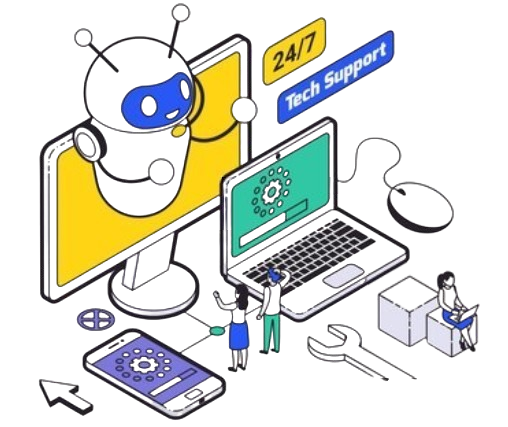Tech Support Automation involves using software tools and technologies to automate routine tasks in customer support. This includes troubleshooting common issues, providing responses to frequently asked questions, and guiding users through step-by-step solutions. By leveraging advanced technologies such as AI and machine learning, businesses can create automated systems that resolve issues faster and more efficiently than human agents.
In today’s fast-paced digital world, providing seamless customer support is crucial for any business. Companies are increasingly adopting Tech Support Automation to streamline troubleshooting processes. The demand for faster, more efficient customer support has led businesses to seek innovative solutions to improve operational efficiency. Automation allows for faster response times, reduced human error, and a more satisfying customer experience.
What is Tech Support Automation?
Tech Support Automation involves using software tools and technologies to automate routine tasks in customer support. This includes troubleshooting common issues, providing responses to frequently asked questions, and guiding users through step-by-step solutions. By leveraging advanced technologies such as AI and machine learning, businesses can create automated systems that resolve issues faster and more efficiently than human agents. The core goal is to improve the efficiency of customer service while reducing operational costs.
In traditional support models, human agents are required to manually address each query, which can lead to slow response times and potential errors. With Tech Support Automation, these tasks can be automated, allowing support teams to focus on more complex issues that require human intervention. The result is an overall more effective support process.
Why is Tech Support Automation Essential?
Businesses are facing growing customer expectations. Customers want solutions fast, and they expect instant responses when issues arise. Tech Support Automation can help meet these demands by offering immediate support through automated systems. Whether it’s responding to simple queries or troubleshooting common technical issues, automation can take the weight off human agents, allowing them to focus on more intricate problems.

Automation also plays a vital role in improving the scalability of tech support operations. As businesses grow and face an increase in customer inquiries, Tech Support Automation ensures that businesses can handle high volumes of requests without compromising service quality. This scalability is crucial for maintaining customer satisfaction as companies expand.
Moreover, automation ensures consistency across responses. Unlike human agents, who may interpret issues differently, This Automation delivers standardized solutions every time. This guarantees that customers receive reliable support, leading to higher satisfaction and trust in the brand.
Key Benefits of Tech Support Automation
- Faster Response Times: Automation reduces the time it takes to address customer queries. By immediately providing solutions to common problems, automation speeds up the troubleshooting process, ensuring customers get the help they need right away.
- 24/7 Availability: Automated systems don’t require breaks, allowing businesses to offer round-the-clock support. This Automation ensures customers can reach out and get assistance at any time, even outside regular business hours.
- Improved Customer Experience: Customers appreciate quick, efficient service. By reducing wait times and offering instant solutions, automation enhances the overall customer experience. A seamless support process improves customer loyalty and retention.
- Reduced Human Error: This Automation eliminates the risk of human error that can occur in manual processes. Automation ensures accuracy in troubleshooting and offers reliable, consistent solutions every time.
- Cost Efficiency: By automating routine tasks, businesses can reduce their dependency on human agents, leading to cost savings. Companies can allocate their resources to more strategic areas while maintaining excellent customer support.
- Increased Productivity: This Automation boosts productivity by freeing up human agents to handle more complex, high-priority tasks. This leads to a more efficient support team and improved performance overall.
- Data Collection and Insights: Automated systems collect valuable data during customer interactions. This data can be analyzed to identify trends, improve the support process, and enhance the overall customer experience.
How Tech Support Automation Works
Implementing Tech Support Automation involves integrating automated tools and systems into existing support processes. Commonly, businesses use chatbots and virtual assistants to automate customer inquiries. These tools use machine learning and AI to recognize patterns in customer requests and provide relevant solutions in real-time.
Additionally, self-service portals and knowledge bases allow customers to resolve their issues without contacting support teams. By providing access to FAQs, video tutorials, and troubleshooting guides, customers can independently solve their problems, reducing the load on support teams. Tech Support Automation makes this possible by constantly updating knowledge bases and providing dynamic, accurate information.
Another important aspect of automation in troubleshooting is remote diagnostics. Automated systems can diagnose and fix certain issues without requiring physical intervention. This reduces downtime and ensures that customers experience minimal disruption.
Best Practices for Implementing Tech Support Automation
To successfully implement Tech Support Automation, businesses should start by identifying common issues that can be automated. This may include troubleshooting simple technical issues or providing standard responses to frequently asked questions. Once these tasks are identified, businesses can select the right automation tools to address these needs effectively.
Additionally, businesses should ensure that there is always a seamless handoff from automated systems to human agents for more complex issues. The automation process should be designed to escalate issues that cannot be resolved automatically, ensuring that customers still receive personalized, expert support when needed.
Moreover, businesses should invest in training for their support teams to handle more intricate problems that require human intervention. By providing proper training, businesses ensure that agents can step in when necessary, improving the overall support experience.
Finally, businesses should continuously monitor and refine their automated systems. Customer needs and issues evolve over time, and the automation system must adapt to meet these changes. Regular updates and improvements to automated systems ensure they continue to provide accurate and efficient solutions.
Conclusion
Incorporating Tech Support Automation into customer support processes has transformed how businesses handle troubleshooting. Automation improves efficiency, reduces costs, and enhances customer satisfaction by delivering quicker, more accurate solutions.
At Tanbits, we help businesses unlock the full potential of automation by providing customized solutions to streamline troubleshooting processes.
Embracing Tech Support Automation is no longer optional; businesses need to stay competitive in an ever-evolving marketplace. By automating key aspects of tech support, businesses can deliver exceptional service while optimizing their resources.
BACK










